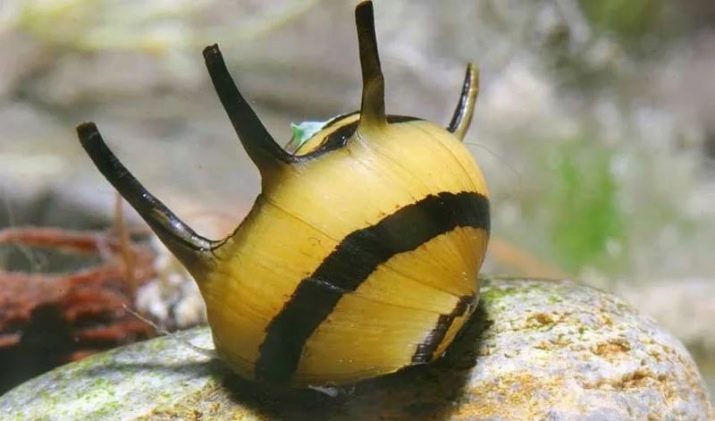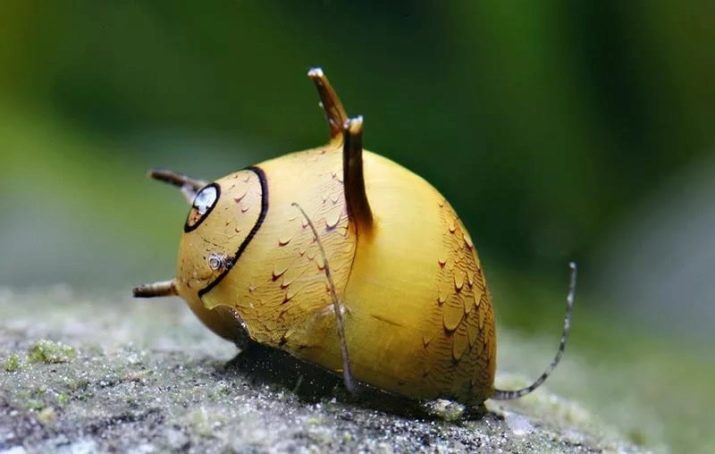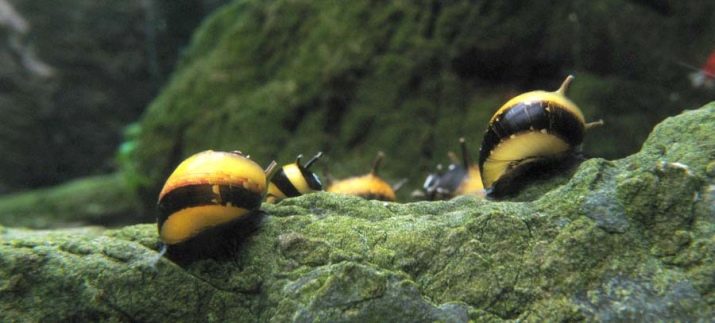Neretina snail: species overview and care tips

In aquariums, you can keep not only fish, but also snails. One of the most common families of gastropods is Neretina. Such snails will not only decorate the aquarium, but also act as container cleaners from various debris.

Peculiarities
Neretina mostly live in salty sea waters, but certain species are freshwater snails. Molluscs are small - usually the shell grows no more than 2.5 cm. Visually, the shell seems to be quite massive, and its shape depends on the individual belonging to a particular type of neretina. There are patterns on the shell, and there may also be protrusions.
It is believed that the pattern of each mollusk is individual, and it is impossible to find a pair of snails with absolutely identical patterns.

The mantle of the mollusk is black in color, and the body itself is painted in a gray tone and resembles an oval in appearance. The snail's mouth is rounded; the eyes are located on slight protuberances. Neretins are not hermaphrodites, but are subdivided into males and females. At home, most species of gastropods belonging to the Neretin family can live for about two years.
The cause of death is most often the improper maintenance and stressful conditions of snails.

Varieties
Neretina is not the name of a specific species of snails, but the name of a whole family. Among its representatives, several popular types of molluscs can be distinguished. Each species differs primarily in appearance, and there may also be differences in behavior and growing requirements.

zebra
Neretina zebra in wildlife lives in Africa.This species is considered one of the largest members of the family - mollusks can grow up to 3.5 cm. The maximum lifespan can be 3 years. The shell of the snails has a golden hue, against the background of which there are clear black stripes. Representatives of this species well clean the aquarium and decorative elements from harmful algae.
A distinctive behavioral trait of neretin zebras is the tendency to escape from the reservoir.

Horned
Horned neretina are found in Africa. Snails can grow up to 1.5 cm in size. Molluscs live quite a long time: from 3 to 5 years. Small growths are randomly located on the shell of snails. Such thorns can break and fall off, but this in no way affects the health and condition of the mollusk. Horned snails are quite calm and do not have the urge to escape from their home.

Tiger
Tiger clams inhabit Asia and the Pacific islands. The shell of snails is usually 2.5 cm long. However, in nature, sometimes larger specimens are found, which can reach 3.5 cm. Representatives of this species live no more than 3 years. As the name implies, snail shells are tiger-colored: a yellow base on which vertical stripes from brown to black are located. The shell is rounded.
These snails do an excellent job of cleaning the aquarium, but tend to escape from it at every opportunity.

Red dot
This variety has another name - ring-striped snail. This species lives in Africa. Their shell is medium in size - up to 2.5 cm, and the life span can be no more than three years. The carapace of this species is red with black spots. The markings vary in size and are distributed in a spiral pattern on the shell. Such snails are thermophilic. The optimum water temperature for their maintenance should be about +30 degrees Celsius. For them, acidity is also important, which should not exceed pH = 7.
In case of violation of the norms, the shell of the snail will collapse, which will lead to the death of the individual. Red dot neretina tend to escape.

Olive
Such neretins are found in Thailand, Indonesia, the Philippines, Japan, and China. This species is one of the smallest among the representatives of the entire family. Individuals reach no more than two centimeters in size. In this case, life expectancy can reach 5 years. This species got its name due to the shell of a bright olive shade. There are dark stripes on the shell.
With proper care, snails do not leave their homes. If the conditions of detention do not meet the requirements, then the mollusks will attempt to escape.

Sunny
These neretins inhabit the territories of China, Thailand, Indonesia, the Philippines and Malaysia. This type can also be found under the name beeline. Molluscs can reach 2 cm in size. The lifespan of snails can be no more than 3 years. A distinctive feature of this type is carapace of an unusual spherical shape. The shell has a ribbed structure and has long growths that visually resemble horns.
It is believed that this species is better than all other members of the neretin family to cope with cleaning an aquarium. However, snails quite often arrange shoots and leave their homes.

Conditions of detention
To grow neretins at home, you need to create favorable conditions for them. First of all, you need to choose a suitable home for them. The size of the aquarium depends entirely on the number of individuals that will live in it. For every 10 small snails, there should be at least 5 liters of free space. If the population is too dense, shellfish may lack nutrients. And also it will affect the parameters of the water.
Snails can be kept in the same aquarium with other living organisms.
These can be peaceful species of aquarium fish and invertebrates. Undesirable neighbors in this case will be fish breeds that lay eggs in an open space, since snails can eat them. Neretina should not be kept together with predatory shrimp species, large and aggressive fish, as well as with representatives of other families of snails.

Since neretins naturally live in tropical climates, it is necessary to create similar conditions for them in the aquarium. The temperature of the liquid in the container should not fall below +27 degrees. Certain species need to be kept in +30 degrees water. In this case, the hydrogen index should be at the level of 7.5. The fluid in the aquarium is changed every day. It is enough to change 30% of the total water volume. The condition of the shell is badly affected by soft water - the level of hardness can vary between 8-12 dH.

As for the soil, then it is better to use a coarse substrate that can be easily washed out. The fact is that some types of neretins very quickly contaminate the filler. As for aquarium plants, snails feed only on algae - you don't have to worry about the integrity of the rest of the vegetation. The lighting in the aquarium should not be too bright. It is best to use the lowest wattage fluorescent lamps.
Do not leave the tank with snails in direct sunlight, as shellfish sometimes rise from the water to the surface and can get severe burns.

The tank with snails must be closed with a lid, otherwise they will escape. Launching shellfish into the tank requires certain rules to be followed. The snails should be carefully placed in the tank and not thrown into a full aquarium. If the individual falls, it can damage the shell, which in turn is fraught with its death. The reservoir should be moderately filled with vegetation and decorative items such as driftwood.
It is desirable that algae are present in the aquarium, which will be food for snails.
After settling in individuals, it is necessary to ensure proper care for them.

Due to poor conditions of detention, neretins can quickly die. A filtration system can be installed to clean the tank. Overpopulation of the aquarium with molluscs, as well as violations of water parameters and temperature conditions, should be avoided.
Snails that have died for one reason or another must be immediately removed from the container, since the decomposition processes start instantly, and the decay products spoil the composition of the water.
Neretina owners should be aware of an interesting fact about one particular feature of this species. Individuals periodically literally freeze in one place and do not show any signs of vital activity from a couple of hours to several days. By mistake, you can consider such a snail dead and throw it away. In this case, there is no need to make hasty decisions. An immobilized individual must be sniffed - a pungent unpleasant odor will emanate from dead mollusks

How to feed them?
The main food source for neretins is algae. However, this will not be enough for full development.
It is advisable to feed the snails with special formulations containing calcium. For example, it can be crushed chicken shells.
Pre-chopped vegetables should be given to neretins. It is best to feed them fresh cucumbers, cabbage and zucchini. They can also be fed with aquarium fish food in the form of powders. The result of improper nutrition will be a lack of minerals in the snail's body, which can lead to cracking of the shell and death of the individual.

Breeding
Reproduction of representatives of the Neretin family can cause certain difficulties for the owner. The first difficulties arise due to the fact that this family of snails does not belong to hermaphrodites, and males and females have no obvious visual differences.
To increase the likelihood of breeding, at least 10 individuals should be kept in one aquarium.

Neretina reproduce by laying eggs. During the incubation period, the water in the aquarium should be salty. Molluscs love to lay their eggs on smooth, dark colored surfaces, so it is best to place a few large rocks in the tank. Visually, the eggs resemble small white dots. It is advisable to move stones with masonry to a separately equipped aquarium with sea water, since adult neretins can eat eggs.
With the aquarium keeping of mollusks, it is quite difficult to get offspring from them. To cope with this task, you need a lot of experience in keeping neretins.

In the next video, you can clearly see how neratina snails help in an aquarium to cope with the cleaning of plants from diatoms.








